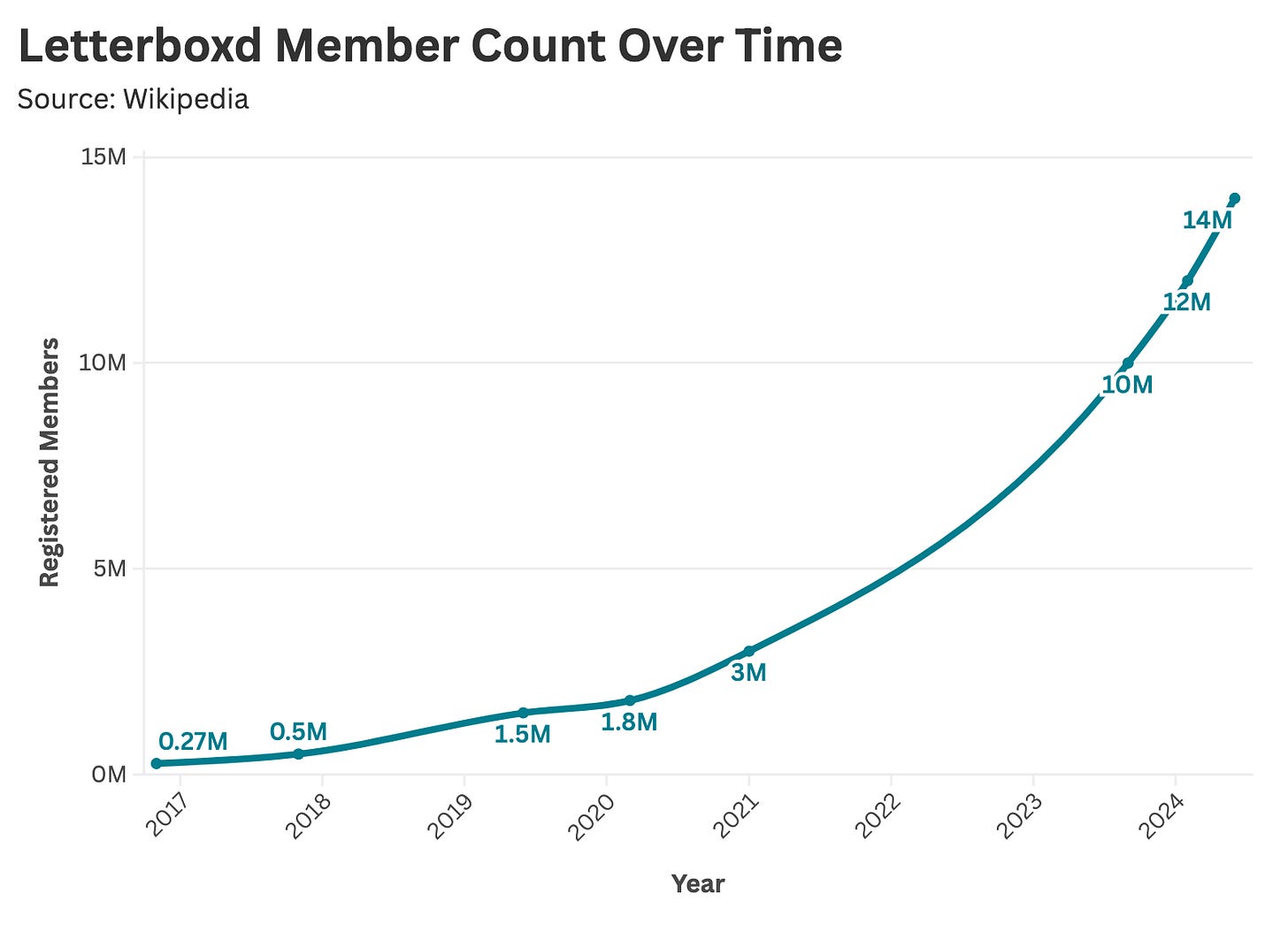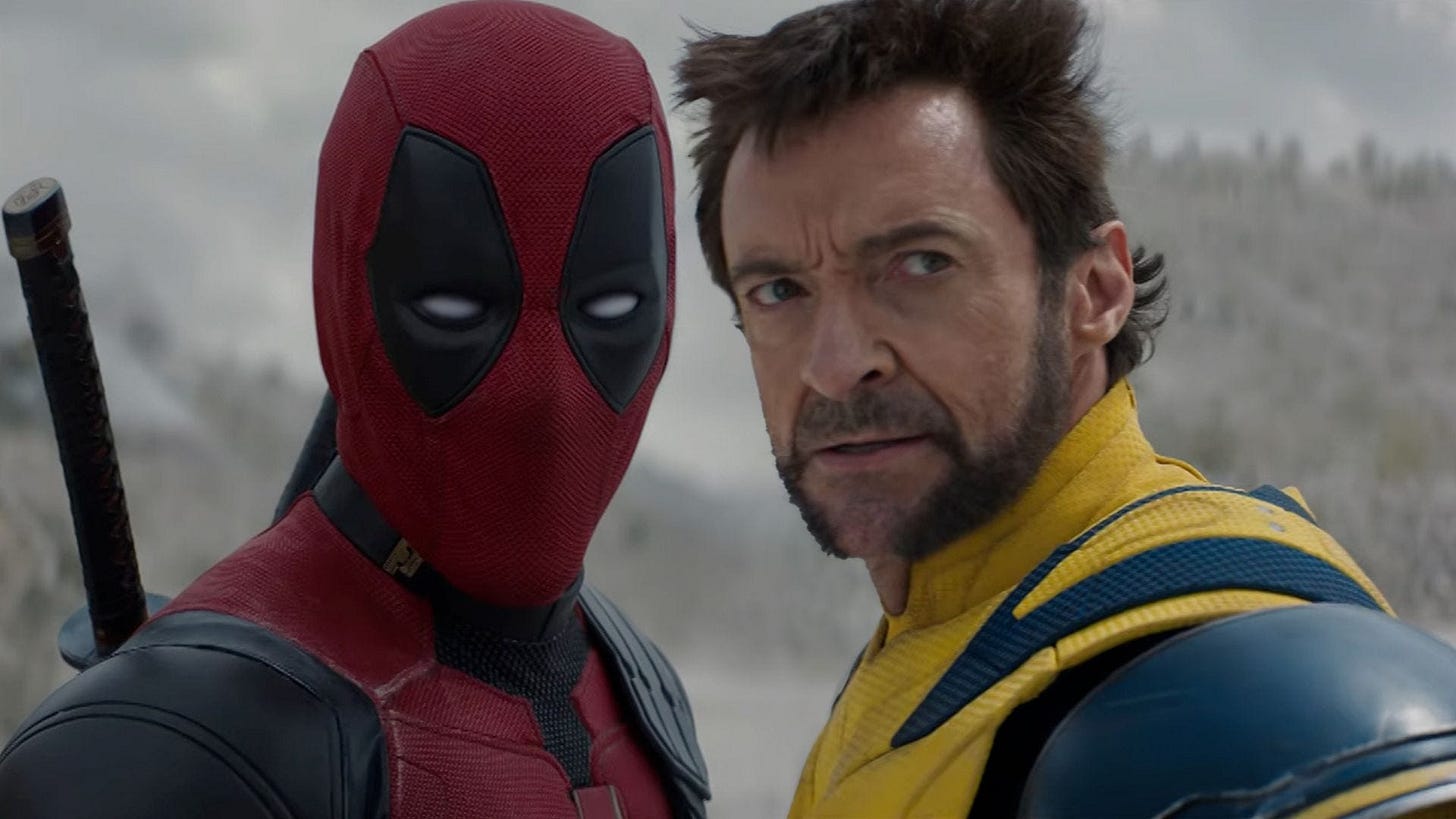6 Reasons to Be (Cautiously) Optimistic About Movies in 2025: A Statistical Analysis
Six reasons to be optimistic about the film industry.
Welcome to the 254 new subscribers who signed up for Stat Significant since our last article! I hope you enjoy this week’s deep dive into film industry trends that inspire optimism.
If you want to discuss data and statistics or need help with an analytics project, email me at daniel@statsignificant.com or connect with me on LinkedIn.
Intro: Everyone Loved "Peak Cinema" of the 1990s
The 1990s are often fetishized as a period of "peak cinema." Moviegoer choice was plentiful, defined by a film market servicing all story formats and customer demographics. Let's say you wanted a dialogue-laden, low-budget indie flick—you could go to your local arthouse for Pulp Fiction, Four Weddings and a Funeral, Swingers, Reservoir Dogs, or any other film festival darling. Interested in a mid-budget thriller targeted at adult audiences? Then go see The Fugitive, The Sixth Sense, Seven, or The Usual Suspects. Craving popcorn entertainment that delights critics and audiences alike? You'll love The Matrix, Titanic, Forrest Gump, or Jurassic Park.
Media pundits often portray the film market of the 1990s as some sort of paradise lost—with 1999 frequently cited as its apex. The turn of the century would bring Marvel's Cinematic Universe, streaming, the death of movie rental stores, DC's Cinematic Universe, The Emoji Movie, a global pandemic, The Angry Birds Movie, and several entertainment industry strikes.
Post-pandemic, media coverage of the film industry regularly frames commercial performance in existential terms. If a big-budget project like Furiosa or The Flash flops, the movie industry is "finished." If a movie like Longlegs or Civil War surpasses expectations, then film podcasters claim the industry to be "so back."
Tracking this ever-shifting seesaw of existential panic and relief is exhausting. It's unlikely that we'll ever replicate "peak cinema" of the 1990s, but that doesn't mean we live in a "dying culture" or an "artistic hellscape wrought by late-stage capitalism."
So today, we'll quantify trends that movie enthusiasts might consider "bright spots" or "not that bad." Enjoy a brief respite from doomsday prophecies of cinema's impending extinction.
But First: A Brief Acknowledgement of the Bad...
The internet does not favor positivity. To express positive sentiment is to be willfully naive—to ignore "how bad things are." 🙉
With this in mind, I will acknowledge some film industry trends that are cause for concern. If you are a sicko who inhales "live updates" or "breaking news" notifications from The New York Times, Fox News, or The Guardian, then these observations will read like comfort food. Enjoy your daily dose of negativity:
2024's global box office was down 45% from pre-pandemic grosses in 2019.
Of the top 20 grossing films of 2024, 16 are sequels or prequels.
The dueling writer-actor strikes of 2023 were a momentum killer for an industry just finding its footing post-pandemic, leading to a 25% reduction in major studio releases (compared to 2019).
Alamo Drafthouse, America's seventh-largest theater chain, went bankrupt before being acquired by Sony.
Paramount—the studio that produced The Godfather, The Godfather Part II, Chinatown, Grease, Apocalypse Now, and several other works of the American film canon—almost went bankrupt as it struggled to scale its Paramount+ streaming service.
I could go on—but I won't. If you're hankering for more of Hollywood's woes, just Google "film industry bad" for endlessly dispiriting content.
The movie industry has indeed hit a rough patch, but two things can be true (at the same time!):
Many things are bad.
Some things are good.
And these sentiments do not nullify one another. Said differently: ¿Por qué no los dos?
1. 2024 Was Not a Box Office Disaster!
On May 2, 2023, the Writer's Guild of America (WGA) went on strike, calling for higher pay, a stable industry-wide compensation model, and increased residuals, among other demands. The Screen Actors Guild (SAG) would soon follow, shuttering industry production until November of 2023.
As a result, 2024 saw a 25% decline in major studio releases relative to 2019, and the initial prognosis for 2024 box office was rather bleak. Industry pundits adopted the maxim "survive till '25" in anticipation of the worst.
And yet, by the grace of God, 2024's box office total will come in a mere 2% lower than that of 2023.
2025 will offer a full-fledged release calendar featuring projects from several big-name directors, including Wes Anderson, James Cameron, Bong Joon-Ho, Paul Thomas Anderson, Ari Aster, Ryan Coogler, and Yorgos Lanthimos.
2. The Growing Popularity and Sturdy Economics of Horror and Thrillers
Horror films remain one of the few dependable genres for original (non-IP derived) storytelling. These movies have significantly smaller budgets than the average film—with adventure, Sci-Fi, and animation projects typically receiving five times the funding of scary movies. As such, horror films don't have to achieve blockbuster sales to turn a profit.
Those who cherish scary movies do so for the visceral reaction they evoke and the communal experience of shared terror in a controlled environment—making horror films well worth the cost of a movie ticket and a trip to the theater.
The atmospheric appeal of this genre has led to a boom in horror and horror-adjacent projects (the latter could broadly be termed "thrillers"), while other genres have struggled to differentiate themselves from streaming fare.
3. The Rise of A24 and Other "Micro-Major" Studios
In a film industry overwhelmed by legacy franchises and endless sequels, A24 stands as a notable outlier, championing a profitable niche of artistically-minded, low-budget theatrical releases.
Since its founding in 2012, A24 has served as a bastion of old-school indie filmmaking, producing smaller-scale, critically acclaimed works like Uncut Gems, The Zone of Interest, Everything Everywhere All at Once, The Iron Claw, Past Lives, and Lady Bird.
Over the past decade, A24 has gradually increased its average gross per project and total annual box office returns.
Hollywood's hipster favorite has set its sights on grander productions and higher grosses, with the $50M budget and $106M box office for 2024's Civil War representing its boldest investment and second highest-grossing film to date.
A24 is the leading example of a "micro-major" studio, a privately-held company specializing in low- to mid-budget releases and doing so at a meaningful scale. Indie studios like Neon and Mubi have also achieved meaningful box office success within this niche. This past year, Neon released the surprise hit Longlegs and Best Picture front-runner Anora, while Mubi made over $77M from The Substance, an unconventional body horror film that somehow found an audience.
Enjoying the article thus far and want more data-centric pop culture content?
4. The Ascendent Popularity of Repertory Screenings
Disillusioned with modern studio films, cinephiles are turning to the past, finding consolation in repertory screenings.
On a small scale, these showings constitute a local arthouse screening of Citizen Kane or The Godfather. At a larger scale, these repertory viewings take the form of coordinated re-releases, with films like Interstellar or The Phantom Menace playing on 1,000 screens at a time.
2024 saw several commercially successful re-releases that made the most of limited theatrical runs (sometimes playing for a single day).
Fathom Entertainment, the company behind most of these events, saw revenue grow by over 45% this past year and has committed to significantly expanding its repertory programming in 2025.
This month, Warner Brothers will be screening a 4k restoration of David Fincher's Seven, which should be equal parts thrilling and gross.
5. Extensive Movie Selection on Streaming Platforms
Movie culture is not solely defined by moviegoing. Let's say you want to watch a movie every other day—you're not accomplishing this feat through theater outings alone. You're likely watching the majority of these titles at home.
Sure, entertainment's pivot to streaming has thoroughly destabilized Hollywood and led studios to cannibalize their film businesses, but streaming platforms pose some positive tradeoffs for cinephiles.
Services like Prime Video and Netflix offer considerable movie catalogs, ensuring nearly every major release (in human history?) can be easily accessed from the comfort of one's home.
Within the span of twenty seconds, you can discover a new film, locate that title on Prime Video, and commence playback.
Separately, there has also been a rise in specialty streaming platforms that cater to niche tastes, such as Criterion's streaming service (for lovers of arthouse films), Shudder (for horror aficionados), and Mubi (for those who like global cinema).
In a vacuum, ample streaming selection is fantastic for movie lovers—though one could (rightly) argue that streamer catalogs indirectly compete with theatrical exhibition.
6. The Post-pandemic Reinvention of Movie Culture: Letterboxd, Physical Media, and More
In the late '90s, there was roughly one movie rental store for every 9,000 people in the United States. These stores served as watering holes for local film culture, providing a locale for cinephiles to discuss movies (since people don't really talk in theaters). These shops bred a generation of film lovers, including high-profile directors like Quentin Tarantino, Kevin Smith, Paul Thomas Anderson, and Richard Linklater.
Fast forward to the present day: video stores are near-extinct, leaving movies without a physical place for community.
In recent years, Letterboxd has attempted to fill the void left by video stores. For those unfamiliar, Letterboxd is a social network for movie discovery where users can rate the films they've watched, create personalized lists, and follow other users to see what they're watching. If IMDb and early-stage Twitter had a baby, it would look something like Letterboxd.
Letterboxd's popularity spiked during the pandemic, and the site has since continued its rapid growth from 1.5M users in 2019 to over 14M users in 2024.
Letterboxd has become the cornerstone of the film nerd starter pack, a grouping of habits and hobbies that include the Criterion Channel, Vulture's Cinematrix quiz, repertory screenings, worshipping A24, the Criterion Collection, and physical media ownership.
Despite most major retailers (Best Buy, Target, etc.) dropping physical media from their catalogs, DVD collecting has remained a pillar of modern film fandom. Movie nerds increasingly favor the tangible ownership of 4k UHD and Blu-ray discs, rejecting the ubiquity and amorphousness of streaming.
In recent years, online communities centered on physical media have experienced substantial membership growth, with Reddit groups dedicated to DVD ownership gaining hundreds of thousands of new members.
eBay, the world's largest platform for trading memorabilia, has significantly benefited from retail's abandonment of physical media. A recent report from Self on "The Best Items to Sell on eBay in 2023" found DVD and Blu-ray to be the third-highest selling category on the site.
Post-pandemic, movies are no longer at the forefront of mainstream culture. In response to film's diminishing economic and artistic footprint, cinephilia has reconstituted itself as something increasingly niche and insular—and that's okay.
Final Thoughts: Loving Film and Not the Film Industry
It's extremely common for movie lovers to follow the machinations of the film industry. At first pass, this is somewhat intuitive—consuming entertainment news is a logical extension of one's passion.
But not every pastime demands that its hobbyists understand how the sausage is made. Book readers are not scrutinizing the publishing industry. Those binge-watching "Squid Game" are not contemplating the show's bearing on Netflix's global expansion.
For some reason, the film industry has foregrounded itself, whereby coverage of its ups and downs accompanies the entertainment product itself.
Even stranger is the growing asset-ization of films in industry coverage. Each movie premiere is treated like a quarterly earnings report, judged by how its box office meets or exceeds expectations. If a release falls short of projections, then that movie is a failure, and if it beats estimates, then everyone must rejoice. Every weekend is a referendum on the continued existence of movie culture—dictated by whether a handful of projects miss or surpass analyst projections.
And guess what? I follow all this stuff. 🙉
Whenever I'm knee-deep in an article about "How The Flash's failure signals the fall of movies," I often remind myself of a zen concept called mushin. I'll admit that referencing Zen Buddhism in an essay about film culture is exceedingly pretentious—I only feel comfortable doing so because I am inept at abiding by this principle.
Mushin roughly translates to "no-mind," a state of effortless presence, free from thought, ego, or attachment. In practice, someone living this ideal would simply enjoy a movie (in theaters and at home) and not scrutinize a film's cascading impact on the future of entertainment.
Have I had any success in my pursuit of "no-mindedness"? Not in the slightest. What lingers (frustratingly so) is an unshakable truth that movies are no longer at the center of culture like they were in the 1990s. Recollections of "peak cinema" serve as a frustrating reminder of what was and what could be.
Yet thirty years from now, the above-mentioned positives might be fondly remembered as relics of "somewhat-peak cinema" of the 2020s. We have no idea if this is the best we'll ever have it or the start of some miraculous moviegoing resurgence. So, enjoy Letterboxd, elevated horror, A24, Neon, Criterion, and horror-adjacent fare while you can.
Nothing lasts forever—not even the movie year 1999.
Struggling With a Data Problem? Stat Significant Can Help!
Having trouble extracting insights from your data? Need assistance on a data or research project? Well, you’re in luck because Stat Significant offers data consulting services and can help with:
Insights: Unlock actionable insights from your data with customized analyses that drive strategic growth and help you make informed decisions.
Dashboard-Building: Transform your data into clear, compelling dashboards that deliver real-time insights.
Data Architecture: Make your existing data usable through extraction, cleaning, transformation, and the creation of data pipelines.
Want to chat? Drop me an email at daniel@statsignificant.com, connect with me on LinkedIn, reply to this email, or book a free data consultation at the link below.
Want to chat about data and statistics? Have an interesting data project? Looking to produce data-centric editorial content? Email daniel@statsignificant.com














Thanks for this, Daniel. I am caught in a downward spiral of deepening concern for the FKATheFilmBiz, somewhat of my own making (at least when it comes to building a list). You brightened my morning.
We love a little optimism